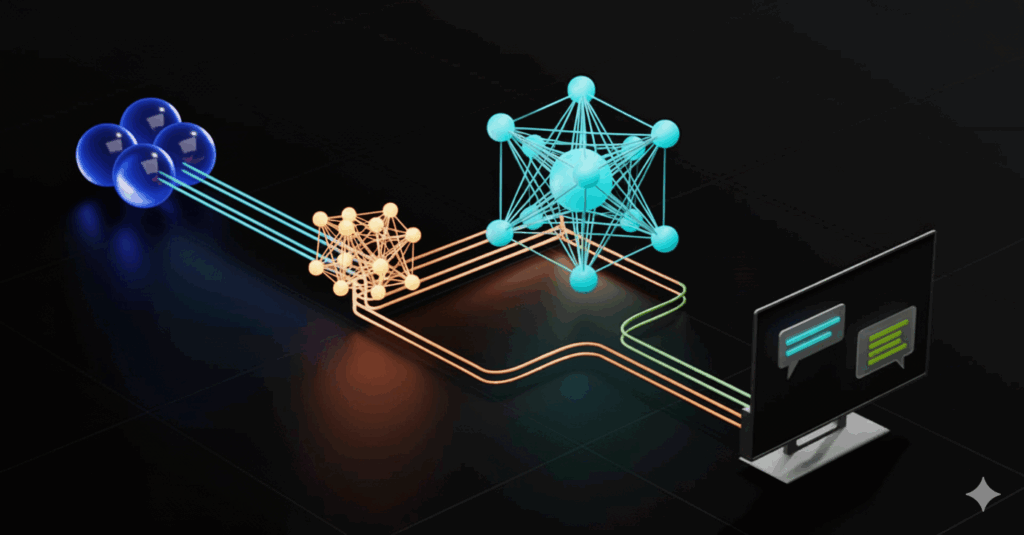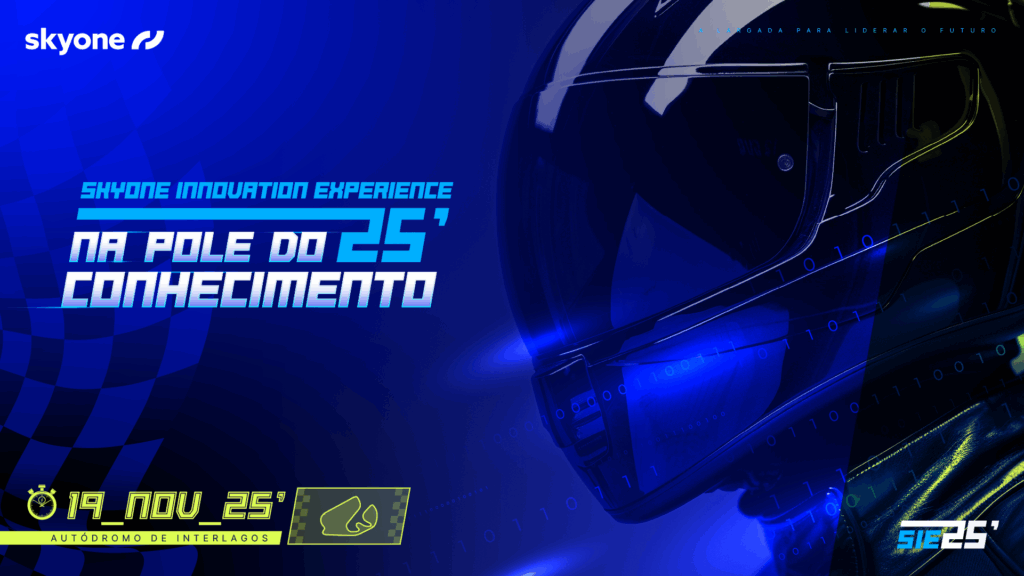In recent years, artificial intelligence (AI) has made inroads into many fields, and Retrieval Augmented Generation, known by the acronym RAG , is one of the most promising innovations. This approach combines information retrieval capabilities with natural text generation, creating more efficient and accurate solutions.
Throughout this content, you'll better understand how this technology works, its benefits, and how it's already transforming different sectors. Enjoy reading!
Where RAG Fits into the AI Universe
Before understanding RAG itself, it's important to remember that there are different approaches to increasing the efficiency and accuracy of AI models. These include:
- Purely generative models , which depend only on the data used in training and may suffer from limitations or outdated information.
- Hybrid models , which combine external information search mechanisms with text generation, as is the case with RAG.
It is in this second group that Augmented Recovery Generation stands out, precisely because it combines the best of both worlds: the recovery of relevant data and the generation of coherent and contextualized content.
Definition: How Augmented Recovery Generation Works
Retrieval Augmented Generation ( RAG) is a technique that integrates two main AI models: an information retrieval model and a text generation model.
The retrieval model is responsible for searching for relevant data from large databases ( learn more about Data Management ), while the generation model uses this information to create coherent and informative responses or content.
This process allows AI systems to not only answer questions, but to do so with a wealth of detail that would only be possible with a vast database. More than 60% of organizations are developing AI-powered recovery tools to increase reliability, reduce hallucinations, and personalize results using internal data.
MAIN CHARACTERISTICS
Furthermore, RAG stands out for its ability to adapt to different question contexts , using the retrieved information to adjust the generated output.
This means that even when faced with complex or ambiguous questions, the system can provide more accurate and satisfying answers . This adaptability is one of the reasons RAG is attracting so much interest in the AI .
Another important feature of RAG is its scalability . By leveraging large data repositories, the technique is capable of handling large-scale queries , making it a valuable tool for companies that need to process large volumes of information quickly. This is especially relevant in sectors where agility and accuracy are crucial, such as finance or healthcare.
Benefits for companies and users
RAG is an innovative technique that brings a number of benefits, particularly when it comes to increasing the efficiency of AI systems. By combining retrieval and generation, systems can produce more accurate and contextually relevant responses, overcoming the limitations of purely generative models , which often rely on limited training data. This is particularly important in scenarios where information accuracy is critical for decision-making.
Another important advantage: RAG allows for better personalized responses . By accessing real-time information, the system can adapt its responses to better meet users' individual . This translates into a richer and more satisfying experience for users, who feel their needs are being met more effectively.
RAG's ability to integrate updated information is also a strength ( see essential data tools for AI ). Unlike generation models that rely exclusively on static data, RAG can access and utilize new information , ensuring that the answers generated are always relevant and up-to-date. This feature is vital in dynamic business environments where information changes rapidly.
Solution architecture: integration between recovery and generation
The RAG architecture is composed of two main parts:
- Retrieval model: This model is responsible for identifying and retrieving relevant information from a large database. It uses advanced search techniques to ensure that only the most relevant data is selected. The effectiveness of this model depends on robust search algorithms that can filter out irrelevant information and focus on the most relevant.
- Generation model: After retrieval, the generation model comes into play. Based on the information provided by the retrieval model, it creates responses or content that are coherent and informative. This model must be trained to understand the context of the retrieved information and generate content that is not only accurate but also fluent and easy for the end user to understand.
The integration of these two models is where the magic happens. The retrieval model feeds the generator with fresh, relevant data, while the generator transforms this information into complete, coherent answers. This synergy is what makes RAG such a powerful tool for practical applications.
Advantages over other AI models
The main advantage of RAG is its ability to provide accurate and detailed answers, even on complex or unfamiliar topics. This is possible because the retrieval model can access a vast array of information, while the generation model ensures that the output is fluent and natural. The integration of these two models results in a system that not only understands the query but also offers valuable insights.
continuous learning capability . As the database is updated with new information, the RAG system can adapt and improve its responses. This means that, over time, the system's responses become increasingly accurate and contextualized, providing increasing value to users.
Additionally , RAG promotes operational efficiency. By reducing the time it takes to find and process information, organizations can save valuable resources. This is especially important in industries where the speed and accuracy of responses can have a direct impact on customer satisfaction and company results.
RAG Applications
Although RAG is a technical architecture, its impact appears in a very practical way in the user experience.
In general, the public does not interact directly with the “RAG”, but rather with solutions built on top of it, such as smarter chatbots, internal corporate search engines, virtual learning assistants, or data analysis systems.
RAG acts as the engine that enables faster, more contextual and personalized responses.
1. Customer service
One of the areas most benefited by RAG is customer service . RAG-based systems can provide fast and accurate answers to customer questions, improving satisfaction and reducing response times. This is especially useful in industries like e-commerce and financial services , where inquiries can vary widely in complexity. The ability to provide personalized and accurate answers in real time can transform the customer experience , creating a competitive advantage .
Furthermore , RAG can help automate customer service , freeing up human resources to handle more complex issues or those that require a personal touch. This not only improves efficiency but can also lead to greater employee satisfaction , allowing employees to focus on more challenging and rewarding tasks.
Another important application is customer feedback analysis . By using RAG to process large volumes of feedback data , companies can quickly identify trends and common issues proactive and effective responses to improve products and services.
2. Education
In education , RAG can be used to create personalized teaching materials . Teachers and students can benefit from content tailored to their specific needs , generated from vast repositories of knowledge . This not only improves the quality of learning but also makes education more accessible and inclusive .
RAG can also be used to develop intelligent learning assistants that help students understand difficult concepts by providing detailed explanations and practical examples . This can be particularly useful in complex subjects like math and science , where conceptual understanding is crucial.
Furthermore , RAG can facilitate academic research by helping students and faculty quickly find relevant articles and studies . This not only saves time but can also inspire new ideas and collaborations , enriching the academic environment .
3. Scientific research
Researchers in various fields can use RAG to explore large volumes of scientific literature . The retrieval model identifies relevant articles , while the generation model synthesizes the information into understandable summaries , saving time and effort . This is crucial in fields such as biomedicine and technology , where the volume of new information can be overwhelming .
RAG can also help identify gaps in existing research , suggesting new directions for investigation . This can accelerate scientific and technological progress , leading to innovations that can have a significant impact on society.
Furthermore , RAG can be used to monitor trends and advances in real time, allowing researchers to stay up to date with the latest developments in their fields. This is especially important in rapidly advancing such as artificial intelligence and nanotechnology .
Current challenges
Despite its advantages, RAG presents some challenges , which can be grouped by themes:
1. Model quality and training
- The accuracy of the recovery model depends on the quality and comprehensiveness of the database used.
- The generation model needs to be constantly trained to maintain the relevance and accuracy of the answers.
- These processes require significant resources in terms of time and technology , which can be a barrier for some organizations.
2. Balance between recovery and generation
- It is necessary for the recovery model to filter out irrelevant information .
- The generation model must interpret and use this information efficiently.
- Failure to do so at any of these points may result in inaccurate or decontextualized responses .
3. Interpreting complex queries
- RAG faces challenges in dealing with ambiguous or poorly formulated queries .
- Developing algorithms that can handle these situations is an active area of research , still with significant difficulties.
4. Privacy and data security
- The use of large volumes of data raises concerns about privacy and security .
- Implementations must follow strict guidelines , protecting against unauthorized access and data leaks .
5. Transparency and user control
- It is essential that users are informed about how their data is being used .
- They must have the option to control their personal information , ensuring trust and compliance with regulations such as GDPR .
6. Bias in the data
- Databases must be diverse and representative .
- This prevents the perpetuation of prejudices and discrimination in the results generated by the system.
The future of technology
Augmented Retrieval Generation is constantly evolving . With continued advancements in AI and machine learning, Augmented Retrieval Generation is expected to become even more integrated into everyday applications. Research is focused on improving the efficiency of retrieval models and creating even more intelligent generation algorithms. This includes the development of deep learning techniques that can enhance the understanding of complex contexts and generate more natural and accurate responses.
There is growing interest in integrating RAG with other emerging technologies, such as augmented reality and the Internet of Things (IoT). This could open up new possibilities for innovative applications that combine real-time contextual information with generated responses.
Another trend is personalization . As RAG becomes more sophisticated, applications are expected to offer increasingly personalized experiences, adapting not only to the context of the query but also to individual user preferences.
Companies that adopt RAG can gain a competitive advantage . By improving the efficiency and accuracy of their customer service and research systems, they are able to offer superior service, increasing customer satisfaction and loyalty. This can translate into increased revenue and a stronger market position.
RAG can also help companies innovate products and services by leveraging data-driven insights to identify new market opportunities and trends. This is especially important in highly competitive industries, where the ability to adapt quickly to change is crucial.
Finally, adopting RAG can improve operational efficiency , reducing costs and freeing up resources to invest in strategic areas. This can provide a significant cost-benefit advantage, especially for companies operating in data-intensive industries.
Conclusion
Augmented Retrieval Generation represents a significant advancement in how we use artificial intelligence to process and generate information. With practical applications in customer service , education , and research , Augmented Retrieval Generation has the potential to transform various industries, making them more efficient user -centric . By integrating retrieval and generation , it offers a powerful solution for the information age .
The future of RAG is promising , and organizations that embrace this innovation will certainly reap the rewards of smarter , more effective . As technology continues to evolve, RAG is expected to play an increasingly important role in our daily lives, influencing how we interact with information and make decisions . With the right approach, this technology can become a true competitive differentiator in an increasingly data .
Author
-
Raquel is a marketing director with 15 years of experience in high growth B2B companies. It works in the development of integrated demand generation strategies, ABM, content and brand positioning, with expansion focus and acceleration of results. Throughout his career, led teams, boosted releases, and supported the entry into new markets. He believes marketing goes far beyond numbers, is about connecting people, solving problems and accelerating success stories.





